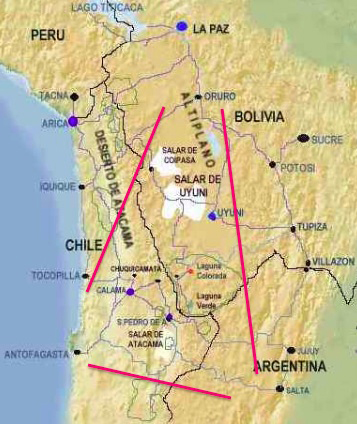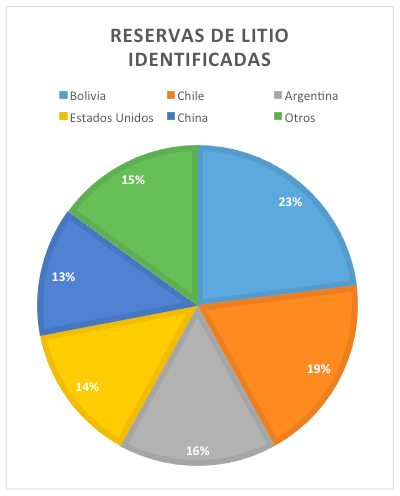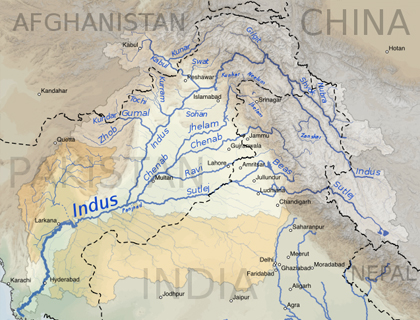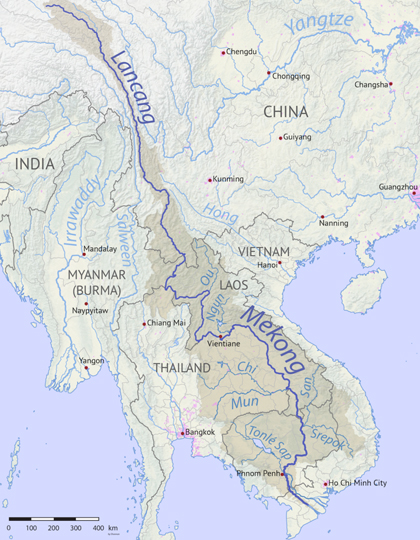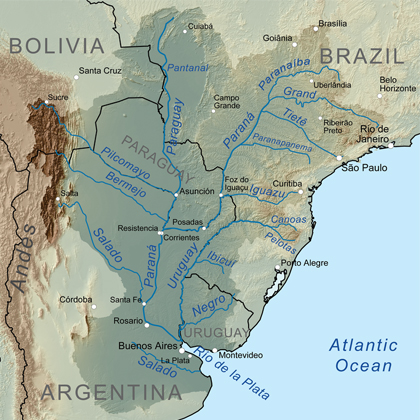Ruta de navegación
Menú de navegación
Blogs
Entries with Categories Global Affairs Energy, resources and sustainability .
The Central Asian republics are fighting over the scarce water resources of the Aral Sea Basin
The lack of effective cooperation between the republics through which Central Asia's two main rivers, the Amu Darya and the Syr Darya, which have historically fed the Aral Sea, flow, is preventing the region's water problems from being resolved. Short-term objectives, such as hydroelectric exploitation or oil exploration, make it difficult to understand, although recent initiatives point in the right direction.
![Satellite image of the Aral Sea, with north below [NASA] Satellite image of the Aral Sea, with north below [NASA]](/documents/10174/16849987/guerra-agua-blog.jpg)
▲Satellite image of the Aral Sea, with north below [NASA]
article / Roberto Ramírez Millán
source of life, food for crops, means of navigation... There are many functions that water fulfills, such as resource human. It is indispensable and necessary for the maintenance and development of any nation. Today this resource It is being depleted due to the great industrial expansion of the last few centuries, mass population growth, and climate change. The dispute over fresh water, given its economic, geopolitical and geostrategic importance, is triggering conflicts between various countries, known as "water wars". That happens in the area of the Asia-Pacific and particularly in the case of the Central Asian region, in the Aral Sea Basin.
Due to the drought that characterizes this area, the Amu Darya and Syr Darya rivers are under particular stress as the main suppliers of fresh water to the countries of Central Asia. Since the collapse of the USSR, together with its organizations for the negotiation of the waters of this basin, and the independence of the countries located in this region, the lack of an effective international organization to regulate the use of this basin, the lack of an effective international organization to regulate the use of this basin, the lack of an effective international organization to regulate the use of this basin, has been the result of the collapse of the USSR. resource between States has led to a series of international conflicts due to inequalities in access to water.
In 1993 the Kyrgyz Republic began using the Naryn waterfall as a source of hydroelectric power, with the intention of making up for the lack of organic fuel. With this new use of infrastructure, which entailed a great retention of water during the summer, the Kyrgyz Republic took the opportunity to sell electricity at exorbitant prices in exchange for gas and coal, which it lacks, to countries such as Kazakhstan and Uzbekistan. The pursuit of the States' own benefit and the lack of cooperation between them made it impossible to achieve any agreement.
In addition, in 1997, Kyrgyzstan declared that the Syr Darya River would cease to be a common good for legal purposes. To this end, it remodeled and restricted the right to use it and required States that benefited from this basin to adopt a financial aid to maintain the freshwater reserves available in their territory. Not satisfied with this, he remarked that if Uzbekistan did not pay, it would sell much of this water to China, thus damaging attempts to reach a treaty. agreement between the two.
These events have not been the only ones that have hindered cooperation between these countries, we could also highlight the sharp global drop in the prices of irrigated agriculture, Uzbek cotton crops that require large amounts of water and the problems resulting from climate change, among others.
Aral Sea
In addition, the current status where the Aral Sea is located. Once one of the four largest lakes in the world and providing economic sustainability to the region, it has been in a state of continuous drought since 1960. Due to the above-mentioned operations on the Syr Darya and Amu Darya rivers, the Aral Sea was divided into two parts, the North Lake and the South Lake, with the eastern part of the South Lake completely evaporating. Previously, the Aral Sea provided between 20,000 and 40,000 tons of fish per year; however, it can currently only supply around 1,000 tonnes.
To deal with drought problems, Kazakhstan developed the project "Regulation of the Darya River Bed and Preservation of the Northern Part of the Aral Sea". This included the construction of the Kokaral Dam on the southern shore of the North Lake, thanks to the support of the World Bank. The dam ensured the growth of that lake by 20%. The project It also provided the Building of a fish hatchery, which fostered a production of between 10,000 and 12,000 tonnes of fish per year.
|
Map of Central Asia |
However, these measures in favour of the development of the Aral Sea are being countered at the same time by the actions of Uzbekistan. If previously the Uzbek part of the Aral Sea was harmed by high irrigation of cotton crops, it is now oil extraction that is damaging the southern lake. Soil drilling in the delta of the Amu Darya River and at the bottom of the Aral Sea play a negative role. In the dilemma between the development of the oil and gas industry and the salvation of its share of the Aral, Uzbekistan is demonstrating what its priority is, given the benefits of the development of hydrocarbons.
Effective cooperation
Researchers and experts in the region are aware that cooperation among the six countries is essential for their development; That is why the Regional Environmental Center for Central Asia (CAREC) was established in 2001, a non-governmental organization tasked with addressing environmental and sustainability challenges in Central Asia and Afghanistan. This organization has denounced that the region is losing 4,500 million dollars annually due to "the lack of effective mutual cooperation between countries", as indicated by its director executive officer, Iskandar Abdullayev.
For this reason, on June 8, the launch ceremony of the Innovation and Innovation Cluster took place with CAREC. research Scientist at the Scope of the management the first in Central Asia, whose goal is "to ensure the effectiveness and sustainability of development". These and similar initiatives are the first steps towards creating a prosperous and sustainable future, avoiding reprisals and preventing possible "water wars".
BIBLIOGRAPHY:
Bernauer, T., & Siegfried, T. (2012). Climate change and international water conflict in Central Asia. Journal of Peace Research, 49(1), 227-239.
Dukhovny, V. A., & Sokolov, V. (2003). Lessons on cooperation building to manage water conflicts in the Aral Sea Basin. Paris: Unesco, 7-16
Karaev, Z. (2005). Water Diplomacy in Central Asia. Middle East Review of International Affairs, 9(1), 63-69.
Sievers, E. W. (2001). Water, conflict, and regional security in Central Asia. NYU Envtl. LJ, 10, 356.
Swain, A. (2004). Managing water conflict: Asia, Africa and the Middle East. Routledge.
Tishkov, V. (1997). Ethnicity, nationalism and conflict in and after the Soviet Union: the mind aflame (Vol. 15). Sage.
The EU has backed down on the project, but Germany still gives support to the Russian initiative
The project of a second set of gas pipelines through the Baltic Sea, in order to transport Russian gas to the European Union without crossing Ukraine, has divided the EU governments. Some Eastern and Central European countries, backed by the United States, argue against any dependency on Russian gas supplies, but Germany keeps its support to the Russian plans.
![The routes of the Nord Stream and the planned Nord Stream 2 pipelines from Russia to Germany [Gazprom]. The routes of the Nord Stream and the planned Nord Stream 2 pipelines from Russia to Germany [Gazprom].](/documents/10174/16849987/nordstream-blog.jpg)
▲The routes of the Nord Stream and the planned Nord Stream 2 pipelines from Russia to Germany [Gazprom].
ARTICLE / Ane Gil Elorri
The natural gas consumption for nowadays is essential to have basic necessities covered. Therefore, it's imperative for everyday life. Nevertheless, it goes through a laborious process before it reaches the consumers. The gas needs to be extracted from the land or sea subsurface, and transported, before it reaches its destiny, being pipelines the most common via of transportation.
The EU's domestic gas production has been declining and the reserves in the North Sea depleted. Therefore, in order to meet demands, the EU has turned to other suppliers; being the most important Russia, Saudi Arabia and Norway. In fact, a lot of countries in the European Union are heavily dependent on Russian imports, especially of natural gas, which often go through transit countries such as Ukraine and Belarus. The decisions are all make through the EU-Russia Energy Dialogue. Russia has the largest gas reserves in the world. With 44,600 billion cubic meters, Russia has 23.9 percent of the world's currently known gas reserves, followed by Iran (15.8 percent), Qatar (13.5 percent), the United States, and Turkmenistan (4.3 percent each).
The most prominent European energy supply is the Nord Stream Pipelines. Nord Stream are a twin set of pipelines that provide gas transportation capacity for the natural gas, which comes from the Western Russia (Vyborg) into Lubmin, Germany, for the distribution into the European gas grid. This system is composed by a set of 1,224-kilometre pipelines through the Baltic Sea, and each hold the capacity to transport 27.5 billion cubic metres of natural gas a year. Line 1 became operational in November 2011 and by October 8, 2012 the system was fully operational, having taken the construction of these pipelines 30 months.
The desire of a grand-scale gas transport between Russia and the western Europe goes back to the 1970's, to the contract between a German company (Ruhrgas AG) and Gazprom (national Russian gas company) to supply natural gas. In 2000 the European Commission recognized the need for a pipeline in the Baltic Sea. In December 2005, the North European Gas Pipeline Company was established and by October 4, 2006, the North European Gas Pipeline was officially renamed Nord Stream. It was finally completed and functional in October 2012.
The Nord Stream project was very ambitious. Nevertheless, it was completed on time, on budget, and without permanently impacting the environment. The Nord Stream Pipeline system is fully operational and capable of transporting up to 55 billion cubic metres (bcm) of natural gas every year to Europe.
Now, a new project is developing based on the success of the Nord Stream Pipelines: Nord Stream 2. This project will benefit from the experience of the previous pipeline, which has set a new high for the environmental, technical and safety standards throughout its planning, construction and operation. The idea is to add a new set of twin pipelines along the Baltic Sea route to increase the capacity of gas transportation in order to meet the demands of Europe. In fact, this new pipeline will create a direct link between Gazprom and the European consumers.
The Nord Stream 2 project is implemented by the Nord Stream 2 AG project company, where Gazprom is the sole shareholder. In October 2012, the shareholders of the Nord stream project examined the possibility of constructing a third and fourth pipeline and came to the conclusion that it was economically and technically attainable. In April 2017, Nord Stream 2 AG signed the financing agreements for the Nord Stream 2 gas pipeline project with ENGIE, OMV, Royal Dutch Shell, Uniper, and Wintershall. These five European energy companies will provide long-term financing for 50 per cent of the total cost of the project.
The entry point into the Baltic Sea of the twin pipeline will be the Ust-Luga area of the Leningrad Region. Then the pipeline will stretch across the Baltic Sea. Its exit point in Germany will be in the Greifswald area close to the exit point of the original Nord Stream. The route covers over 1,200 kilometres.
The total capacity of the second twin set of pipelines is 55 billion cubic metres of gas per year. Therefore, the sum with the prior pipelines would give an outstanding number of 110 billion cubic metres of gas per year. Nord Stream 2 will be operational before late 2019.
This project is defended with the argument that it supposed a diversification of the routs transporting natural gas to Europe and to elevate the energetic security due to the instability of the transit of gas through Ukraine. For now, a lot of the natural gas consumed by Europe comes from Russia through Ukraine. Nevertheless, if this project goes through, Ukraine will lose 2,000 million dollars for the transit of natural gas, and even the proportion of gas will decrease (which is also for staff use) leading to the collapse and finalization of the transit of natural gas through Ukraine. Furthermore, if Hungary, Slovakia and Poland receive natural gas through the Nord Stream 2 pipelines instead of through Ukraine, it will be very difficult that Ukraine receives gas from the west, seeing as Gazprom along with others controls EUGAL (European Gas Pipeline Link) can reduce the supply of gas to those companies that provide gas to Ukraine.
The cost of 1,000 cubic meters in 100 kilometres through Nord Stream 2 would cost 2.1 million dollars while through Ukraine it costs 2.5 million dollars. The tariff of transportation of natural gas through Nord Stream is 20% lower than through Ukraine.
|
The main Russian gas pipelines to Eastern and Central Europe [Samuel Bailey/CC]. |
Only half of the European Union members approve the negotiations between the EU and Russia over the Nord Stream 2 Project. It is true that the natural gas demand of Europe is growing each year but some countries such as the Baltics are against anything that has to do with Russia. Besides the US, thanks to fracking, has become the biggest producer of gas, and is now looking to substitute Russia as the main gas supplier of the EU.
But other countries are in favour of this project. In January 31 this year, Germany gave its permission to begin the construction of the pipelines of Nord Stream 2 in their territorial waters. Berlin also authorized the construction of the section of 55 kilometres that will go through the terrestrial part situated in Lubmin. In April this year, Finland has also given the two permissions needed to begin the construction.
Nevertheless, Gazprom will be facing a few difficulties in order to pull through with this project. The company still needs that other countries, such as Norway, Denmark and Russia, give authorizations and permissions to construct the pipelines in their exclusive economic zone. There is a risk that Denmark doesn't authorize these new pipelines. The Danish Agency of Energy and the Foreign Office both have to give their approval but can deny the permit if Nord Stream 2 represents a danger for the environment. Another problem is purely political: the European Commission is trying to make the implementation of the project fit with the EU legislation. In November 2017, the European Commission prepared a list of amendments to its energy legislation, known as the Third Energy Package, which will pursue gas pipelines that come from the markets of countries that have the Brussels standards. Because of this, Gazprom won't be able to be the only shareholder of the Nord Stream 2 project and the pipelines will have to carry gas of other companies that have nothing to do with Gazprom.
Although, as previously mentioned, Nord Stream 2 has already received the two permits necessary in Germany and Finland in order to begin the construction, it seems that not many European countries are in favour of this project. In fact, since this April, the EU and the European Commission have withdrawn their support claiming that Nord Stream 2 does not encourage the diversification of gas supply, and they give more significance to the gas pipelines going through the Ukrainian territory in context of diversification of supply routes.
Other EU countries and of the region, such as Ukraine, Denmark, the Baltic States and Poland, have continuously spoken against Nord Stream 2, claiming that the project will increase Europe's dependence on imported Russian gas. Nevertheless, German Chancellor Angela Merkel supports this project, considering it to be an economic project which does not pose a threat to EU energy security, has is expected, seeing as the Nord Stream 2 is a joint venture between Russia's Gazprom, France's Engie, Austria's OMV AG, the Anglo-Dutch company Royal Dutch Shell, and Uniper and Wintershall, both German.
Nevertheless, the most vocally active countries against this project are the US and Ukraine. On one side, the United States believes that this project would undermine Europe's overall energy security and stability. It would also provide Russia other ways to pressure European countries, especially Ukraine. The US even threatened the EU firms to be subjected to Countering America's Adversaries Through Sanctions Act (CAATSA). On the other side, Ukraine's efforts to prevent the implementation of Nord Stream appears to be futile. They openly stated that this would conclude on the Russian monopoly on the world gas market, which would lead in Europe to an energy crisis and to an economic and political destabilization, and called for the international community to step in. Unfortunately, Germany is as headstrong as ever, stating that underwater pipeline to bring gas from Russia could not go forward without Ukrainian involvement in overland transit.
As the recent expulsion of European diplomats in Moscow shows, the global political relations have worsened considerably in the last few years. In fact, some would say that it the worst condition since the Cold War. This new political situation has had consequences on the Nord Stream 2, causing European countries to oppose to this project. The ultimate defender left standing of the programme is Germany, even the EU has backed down after Ukraine's protest. Ukraine has every right to oppose to this project, seeing as Russia has had nothing more but cold moves towards this country(cut off gas supplies in the middle of winter, Crimea), and is not outrageous to think that this project would ultimately affect the country, especially economically. Therefore, this project does not diversify the sources of natural gas, the first Nord Stream already reached this objective. The second Nord Stream, however, would grant Russia a monopoly of natural gas, which is not recommendable seeing as it would create Europe's dependence on Russia, and Russia could take advantage of it. Unfortunately, Russia will not give up this project, even with mostly everybody turns against it.
Domestic demand will increase, unlike in more advanced regions
In the coming decades, oil consumption in Latin America will continue to grow, in the face of a trend towards leave which is already on the horizon of many advanced countries. Population growth and the increase in class average explains this increase in demand. This domestic demand will serve to strengthen the extractive industries of Latin American crude oil producers, but it will make the region's refining deficit chronic.

article / Ignacio Urbasos
The oil industry is experiencing a change in export and consumption patterns in the Latin American region. The sector's classic orientation towards the United States has changed in a new context in which exports are much more diversified with a tilt towards emerging Asian countries. Similarly, domestic demand is steadily increasing due to population and economic growth. However, the region's refining capacity will remain inadequate. This paper will offer a long-term analysis to try to offer a better understanding of the region's energy future, mainly in its consumption, extraction and subsequent refinement.
First of all, Latin America's demographic and economic expectations must be taken into account: population growth will increase by 800 million people by 2050, and economic growth could be 2% per year for at least the next decade. The direct effect of this will be the increase in electricity demand by 91% by 2040 and the increase in issue of vehicles in the region from 94 million in 2016 to the 165 million expected by 2040.
As can be seen in the graph below, the greater demand for oil in the region will be associated with transport, which will tend to be more efficient in consumption, but the promised arrival of the electric car is still far away, with expectations of less than 4% by 2030 worldwide. Similarly, the increase in the class average 126 million people by 2030 will have a direct impact on the increase in air travel, which is projected to grow by average 3.4% per annum until 2034, agreement to the last report of ICAO, with a consequent increase in kerosene consumption.
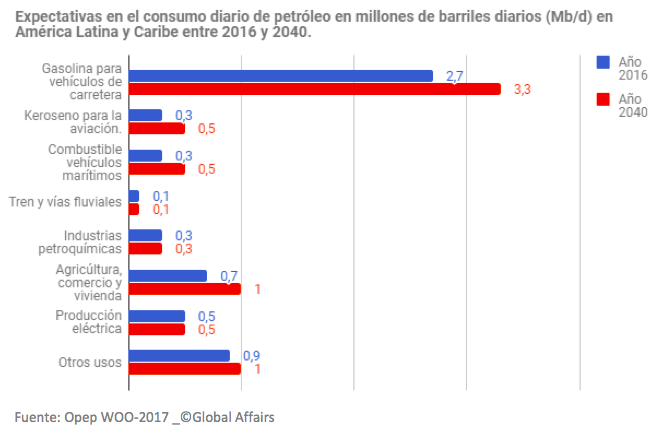 |
It should be borne in mind that in Latin America there are subsidies for both gasoline and diesel, which generates more affordable prices and distorts demand clearly upwards. These subsidies respond mainly to the logic that citizens should be beneficiaries of their country's possession of natural resources, and are concentrated in traditionally oil-producing countries such as Ecuador, Venezuela, Mexico or Argentina. However, these countries import fuel to a large extent due to their limited refinery capacity, generating a double trade and fiscal deficit, as ECLAC points out. The future of these subsidies is unknown, but any change would have a high political cost, since by affecting the price of a basic good it would have consequences on broad social sectors with great electoral impact.
For its part, oil's contribution to electricity generation will remain constant at 500,000 barrels per day, decreasing its importance from the current 46%, according to figures for Latin America from the International Renewable Energy Agency. The region will benefit enormously from the increased presence of renewable energies, a sector that it already leads due to incomparable geographical conditions, highlighting the enormous importance of hydropower.
Over the next few decades, two major phenomena will occur in Latin America: the universalization of access to energy and a new model energy with less presence of oil and biofuel (wood and waste) in favour of gas and alternative energies. One of the great challenges facing the region is to develop a more integrated electricity system nationally and internationally that increases consumption efficiency and allows greater flexibility in production sources. The geographical uniqueness of the region requires enormous investments to carry out this task; however, there are already several regional projects in this direction: the Andean Electrical Interconnection System, which includes the countries of the Andean Community plus Chile, and the Central American Electrical Interconnection System (SIEPAC).
Refining deficit
This increase in consumption is not accompanied by greater refinery capacity, which is already enormously deficient, and generates a critical dependence on imports of gasoline and other derivatives from the US. A trend that is likely to be a constant in the short and medium term for the region and is added to the 14% decline in refinery activity in the region since 2012 (World Oil Outlook 2017), which already adds up to a loss of one million refined barrels per day since that year. High installation and maintenance costs, around 2% of the annual installation cost, add to the region's chronic political uncertainty that largely scares away private investment.
An illustrative case is that of the Pacific refinery in Ecuador, which was presented as the largest project refinery in the country at the beginning of Rafael Correa's presidency in 2007. The project began with a financial stake of 49% by PDVSA and 51% by Petroecuador, in addition to the award of the project to the construction company Odebrecht. As of today, PDVSA has withdrawn its contribution and the Brazilian construction company is facing trials in the country for corruption. result a lost decade and forcing Lenin Moreno to reformulate the project, including the name: now Manabi Refinery.
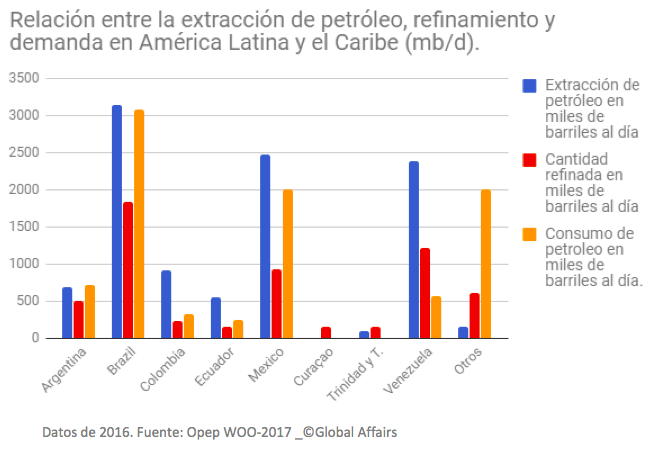 |
As we can see in the graph, the large oil producers in Latin America have a deficient refinery capacity. It should be borne in mind that there is not only an undercapacity in the region, but also an under-activity, which creates an even greater gap. The activity of these plants is currently around 70% of their total capacity. Those countries that do not have oil production, but do have a relevant refining industry, are Curaçao, which has one of the largest PDVSA centers, Chile and Peru.
In final, the Latin American oil sector faces the coming decades with enormous doubts about its refining capacity and far from achieving self-sufficiency. The lack of capacity to attract foreign investment from historically oil-producing countries has generated a disappointing scenario that aggravates the already limited industry in the region. The social transformations inherent in a society that is growing demographically and economically require investment in infrastructure in order to meet the expectations of universal access to education. network and the incipient consumption of the incipient class average.
Nearly two-thirds of the world's identified lithium reserves are in Bolivia, Chile and Argentina
The explosion of the electric automotive industry through the use of lithium-ion batteries has put the large reserves of this metal in the Bolivian highlands and the Atacama Desert at the center of global interest in this new industry. Will South America take advantage of the opportunity to enter into processes of technological innovation itself, or will it resign itself, as has happened with so many other minerals, to a mere work of extraction?
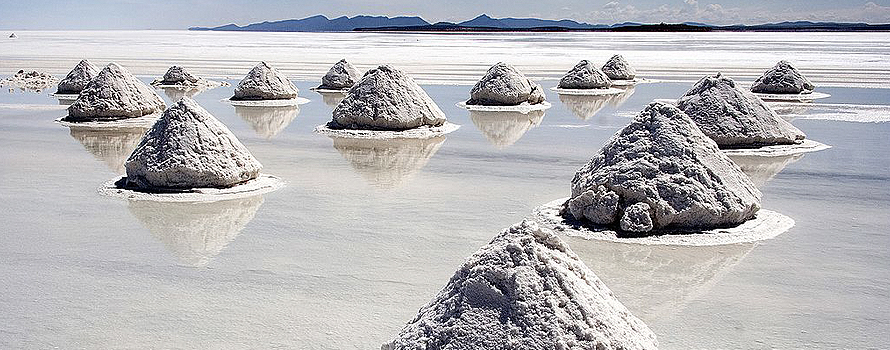
▲Salar de Uyuni, in the highlands of Bolivia [Luca Galuzzi, Wikimedia Commons]
article / Milene Pardo-Figueroa
With the gradual introduction of electric vehicles into the market, as well as the increase in the sale of smartphones, laptops, tablets and other electronic devices – all of which are powered by lithium-ion batteries – the global demand for lithium is increasing. This alkaline chemical element, which in its pure form occurs as a soft, particularly light metal, is abundant in nature, although the largest reserves are concentrated in a few countries. Due to the conditions of its extraction, it is especially profitable in the dry areas of the triangle bounded by the borders of Bolivia, Chile and Argentina. If lithium is known as "white oil" or "new gasoline", because of the color of the saltpeter of the deposits where it is found and because it is the driving force of modern automobiles, the border area of these countries is called the "Saudi Arabia of lithium".
The lithium "fever" has led to a current production of 40,000 tonnes per year, a figure that falls short of the huge demand that currently poses a need of 180,000 tonnes. Although this volume may be reached in the coming years, estimates speak of a demand of between 500,000 and 800,000 tons in 2025. By then, agreement With some forecasts, the global lithium battery market could be worth $46 billion. Part of the industry's push comes from the innovation of electric cars. The expansion of that market, however, could be slowed if lithium production is not accelerated. As visionary entrepreneur Elon Musk, promoter of the high-end electric car brand Tesla, has warned, "in order to create 500,000 vehicles a year, we basically have to retain all the lithium generation on the planet."
The difficulty in meeting this growing demand comes from the high extraction costs, which vary considerably depending on the characteristics of the deposit. The most profitable deposits are found in brine concentrates in arid climates, which experience rapid evaporation when brought to light. The place where this especially happens is the area formed by the Atacama Desert and the Bolivian highlands.
World production is led by Australia, which in 2016 extracted 14,300 tonnes, followed by Chile, with 12,000, and Argentina, with 5,700, of all tonnes. agreement with figures from the U.S. Geological Survey . The volume of reserves identified places the South American countries clearly ahead, especially Bolivia, which has the largest deposits, although for now there are development There is little mining activity for this metal. Thus, Bolivia has identified reserves of 9 million tonnes (22.7% of the world total), Chile 7.5 million (18.9%) and Argentina 6.5 million (16.4%), which means that the three countries have 58% of the world's reserves. They are followed by the United States, with 5.6 million (13.9%), and China, with 5.4 million (13.6%). Other estimates give China reserves similar to Argentina's. The sector is dominated by five large companies, which control 90% of global production: SQM (Chile), FMC and Albermarle (USA), Talison (Australia) and Tianqi Lithium (China).
|
The Lithium Triangle |
Lithium reserves identified |
The White Triangle
The Salar de Uyuni in the Bolivian highlands – a salt-covered surface generated by the evaporation of seawater that was enclosed in a lake when the Andes mountain range emerged in its training– is home to what could be the world's largest lithium deposit. Obtaining it faces the problem that here the metal is specially mixed with magnesium and the separation of the two requires access to technology that Bolivia does not currently have on a large scale. Faced with the fear that foreign companies will be the ones to control the extraction and leave little benefit to the country, as happened historically with the development For the time being, the government of Evo Morales has opted for limited exploitation. Bolivian authorities have preferred to prevent the penetration of multinationals, in order to ensure that the South American nation maintains control of the business. Morales has announced plans for the commissioning, with public funding, of a facility for the manufacture of lithium carbonate at the Uyuni salt plant.
Lithium exploitation is much more advanced in Chile, a country that accounts for around 33% of the world's supply, thanks to the large deposits in the Atacama Desert and the development of an industry of its own. The Society Chemistry and Minera de Chile (SQM), a private Chilean company, leads the national sector, where concessions are tightly controlled by the state. For its part, Argentina is taking steps to boost the lithium business; To that end, the government of Mauricio Macri is proceeding with the liberalization of the sector and has established contacts to attract foreign capital.
Beyond the economic benefits that these South American countries can obtain from the lithium mining boom, a discussion about the ecological impact that it can cause in places as unique due to their natural characteristics as Atacama or Uyuni; There are voices that warn that the Andean saline solution may be doomed to disappear in order to satisfy foreign interest in batteries. There are also fears of a social impact, with no compensation for the human groups settled in the affected territories.
On the other hand, the negative impact that the perpetuation of an economic culture of extraction has historically had in Latin America advises Bolivia, Chile and Argentina to take advantage of the occasion to try to develop their own transformation initiatives and new technologies in the generation of batteries, without limiting themselves, as is the case with so many other minerals, to an extractive activity.
Local Tribes Call for Benefit-Sharing and Reduction of Environmental Damage
The social stability of Nigeria, one of the most populous countries in the world and the largest in the world, is the world's largest Economics of Africa, is of international concern because of its potential impact on continental and global security. Hence, a local conflict such as the one between the tribes of the Niger Delta and the Nigerian government, as a result of the exploitation of the abundant oil of the area, be followed closely from the outside.

▲The area of light at the bottom of the satellite image corresponds to the oil facilities of the Niger Delta [NASA]
article / Baltasar Martos
The fierce dispute over energy resources at the mouth of the Niger River in southern Nigeria has been one of Africa's most high-profile conflicts for decades. The marginalization, confinement, and impoverishment of the Ogoni and Ijaw – the name given to the ethnic tribes in the coastal provinces of Rivers, Bayelsa, and Delta – have contributed to an escalation of tension between locals and the federal government.
In order to understand the underlying problem, it is first necessary to take a brief look back in time and discern the three chronological stages that have shaped the current panorama of the conflict, namely: the beginning of oil exploitation, the hegemony of Royal Dutch Shell and the post-independence period.
In 1903, in the southern coastal region of present-day Nigeria, which became a British protectorate (1901) and later a colony (1914), a large deposit of minerals and hydrocarbons, such as coal, bitumen, oil and natural gas, was discovered. The British company Nigeria Properties Ltd. then began oil exploration and extraction, reaching a production of 2,000 barrels per day in 1905. Later, in 1937, and after the succession of several oil companies, the Anglo-Dutch multinational Royal Dutch Shell acquired a monopoly on the exploration of oil sources – and, to a lesser extent, other hydrocarbons – reaching a number of fees production of 5,000 barrels per day.
Three decades later, following independence and the official establishment of the Federal Republic of Nigeria (1960-1963), the military government of Yakubu Gowon embarked on a policy of nationalization and acquisition of foreign firms in the country, forcing them by legal mandate to re-register through joint ventures with state-owned enterprises. In this way, he managed to transform this activity into the main strategic sector for the Economics of the country. In addition, taking into account the entrance Nigeria joined OPEC in 1971, it is not surprising that the federal government currently owns 60% of the capital stake in practically all the oil companies in operation, occupying an important role as a leader in the country. partner majority.
On the contrary, the civilian population in the area has result The big loser. The ethnic minorities most affected by prospecting, extraction and commercialization activities – with the consequent enrichment for some and environmental pollution for others – have been demanding the attention of the government and demanding legislative measures for environmental and social protection for decades [1].
On the one hand, locals demand "environmental justice," defined by the U.S. Environmental Protection Agency as "fair treatment and meaningful participation in political decision-making processes about activities that affect the natural environment of all peoples, regardless of race, color, culture... concerning the implementation and enforcement of environmental laws, regulations, and policies."
The Ogoni and Ijaw are peoples dedicated mainly to agriculture and fishing as a means of subsistence, for whom the natural environment is the only and main one source of wealth. They are protesting against the long-standing collusion (since independence) between the government and multinational oil companies, calling them both "expropriators and polluters" and blaming them for the impoverishment of the region and the deplorable state of the rivers that flow through it. They also claim their rights to obtain and use, for their local communities, the corresponding share of the profits derived from the exploitation of energy deposits because they are traditionally located on a large pocket of crude oil [2].
Corruption, clientelism and the structural weakness of the government, added to its great interest in and dependence on this sector – which has come to be a benefit for the Economics The national increase of up to 55% of GDP in the mid-1990s according to World Data Bank statistics – makes it extremely difficult for the president and his cabinet to agree to address the needs of these communities in the Niger River Delta. The growing protests led to a real conflict, which began in the last decade of the last century, pitting the civilian population against the federal government in collusion with the multinationals. This confrontation has taken two forms, one peaceful and the other violent, and has attracted the media attention of a large part of the international community.
International Attention
On the other hand, the conflict in the Niger Delta is a clear case of globalization, since oil extraction involves a set of transnational forces, non-state actors and interdependent processes. Fruit of the prolonged status In response to the discontent of the indigenous tribes of the area, two movements have grown in denunciation of profit by a government that barely invests in the development of this region of the country, mired in poverty and poverty. withdrawal, and degraded by the exploitation of its natural resources.
On the one hand, there is the Movement for the Survival of the Ogoni People (MOSOP), created in the wake of protests in the 1990s and used as a model for other civil associations to publicly express their dissatisfaction with the negative impacts of the oil industry on the quality of life of the inhabitants of the area. This organization, started by writer Ken Saro-Wiwa and composed mainly of academics and teachers, peacefully denounces the joint actions of the government and the corporations installed in the area and advocates for the civil human rights of the Ogoni to decent housing conditions, environmental justice and legislation that respects and protects them from environmental threats.
On the other hand, there is the Movement for the Emancipation of the Niger Delta (MEND). It is made up of an amalgam of armed youth groups organized into local resistance militias, whose goal The main one is to fight for control of the oil benefits for the ethnic minorities settled in the area. This is a military branch of MOSOP that has already sabotaged oil pipelines and kidnapped foreign factory workers, demanding ransom from the government on several occasions.
The most important thing about both movements is that they have caught the attention of a large number of people. issue local and international non-governmental organizations that have partnered with them and have begun to promote and to make their cause visible to the entire international community. Amnesty International, Human Rights Watch and the Niger Delta Human and Environmental Rescue Organization are some of the many organisations that have opened a space for work devoted solely and exclusively to the question of the Niger Delta. They advocate worldwide for the defense of the environmental rights of communities affected by the exploitation of resources and the pollution of the natural environment. They have also been able to partner with transnational media and human rights networks to spread the status from conflict to a global audience.
The joint denunciation of the "alleged violations of human and environmental rights against the members of the Ogoni ethnic group of the Niger Delta" has resonated worldwide and has obtained a significant sum of economic aid aimed at the re-establishment of the settlements from which the indigenous peoples had been displaced, as well as the promotion of environmental justice. the protection and guarantee of the civil rights of locals to take advantage of the natural wealth of their area, the continuation of their economic activities and the safeguarding of their environment. The global impact of this conflict is likely to have an impact on how similar conflicts are resolved.
[1] Obi, Cyril. "Insights from the Niger Delta", Young, Tom. Readings in the International Relations of Africa. Indiana University Press, 2016.
[2] Botchway, Francis N., ed. Natural Resource Investment and Africa's Development. Edward Elgar Publishing, 2011.
It generates many of the raw materials needed for global technology production.
China not only has significant reserves of mineral resources, but also leads the world in the production of many of them. B This gives it a geopolitical advantage as source of the resources essential for global technological production.
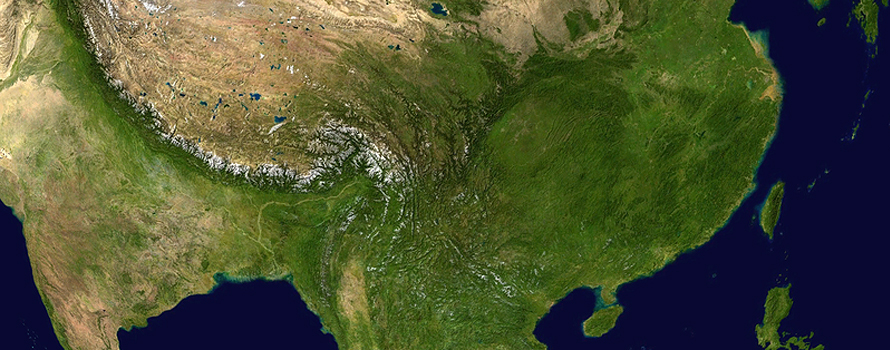
▲Satellite image [NASA].
article / Gabriel Ros Casis [English version].
With such a vast territory as the Asian country, it is obvious to think that it possesses a large amount of raw materials and natural resources. Throughout China's history, this has become a strong geopolitical asset, not only for the country's own development but also for its trading partners through exports. Today, when we talk about these raw materials, China stands out in two main groups: base metals and technological elements.
The group of the base metals essentially comprises five metals from the periodic table, these being: iron, copper, aluminum, magnesium and zinc (sometimes lead and tin are also included). There is no need to recall that we can find all these metals in everyday objects, and that they have been the backbone of industry for a long time. Therefore, every country needs them, placing those with the largest deposits of these metals at a strategic advantage. But a country's mineral wealth is not always given by this condition, as it can also be measured by the ease and feasibility of extracting the product. In the case of China, both arguments would be valid, since the country has the largest deposits of many of these minerals, with magnesium leading the way (79% of global extractions) followed by tin (43%) and zinc (31%).
As far as technological metals are concerned, it is important to note that they include various minerals, such as rare earths, precious metals, as well as semiconductors. From a quantitative approach , the required amount of these metals is minimal, even though their availability is crucial for the production of today's technology. For example, some of the most common technology metals include lithium, yttrium, palladium, cerium and neodymium, which can easily be found in cell phone batteries, medicines, magnets or catalysts. Once again, China leads the way with the largest deposits of several of these elements, especially tungsten (83%), followed by rare earths (78%) and molybdenum (38%).
From this we can conclude that China not only has the largest deposits, but is also the world's leading exporter. In addition to extraction, this country also refines and manufactures components with minerals such as aluminum, copper and certain rare earths, and in some cases even manufactures the final product.
Therefore, it must be taken into account that extraction brings with it certain consequences. Environmentally, extraction always has an impact on the land, perhaps less in China compared to other countries (due to the size of its territory), but equally significant. From an economic approach , these extractions entail a great cost, but which, managed in the right way, can generate an immense benefit. In the political scenario, they are seen as an important geopolitical advantage, creating dependence on the demand of other countries.
As a conclusion, it can be drawn from this that China has great power in terms of raw material resources, but this carries with it a great responsibility, since a substantial part of the raw materials used for almost all the world's technology production depends on this country, which provides the resources, but also manufactures them.
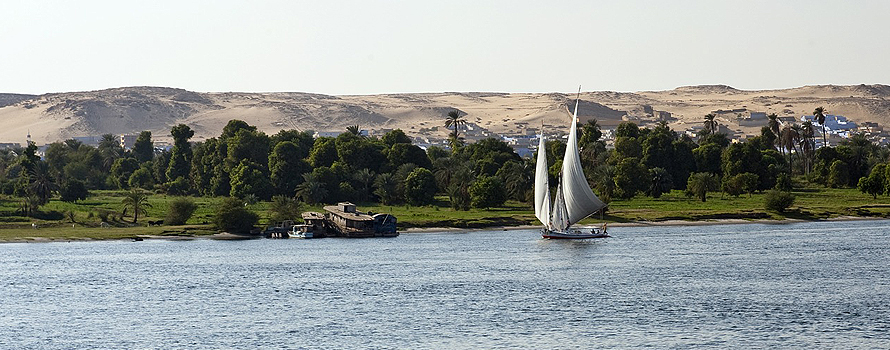
▲Lower Nile River, Egypt [Pixabay]
ANALYSIS / Albert Vidal [English version]
Disputes over control of rivers, lakes, and, in particular, final, are particularly alive today and will intensify in the near future, since, according to the World Health Organization, by 2025 half of the world's population will live in water-scarce areas. Currently, the countries with the most water reserves are Brazil, Russia, the United States, Canada, China, Colombia, Indonesia, Peru, India and the Democratic Republic of Congo. Most water available It is found underground, concentrated in aquifers, or surface water (rivers and lakes). The aquifers with the largest reserves are the Nubian Sandstone Aquifer System (under the Sahara Desert), the Great Artesian Basin (in Australia), and the Guarani Aquifer (in South America). On the other hand, there are a number of rivers in the world that are of exceptional importance, simply because of the enormous amount of population and economic activity that depend on them. Problems arise when these rivers are not part of a single State, but are contiguous or transboundary rivers, and that leads to disputes between some States.
Flashpoints in Asia
Asia is being particularly affected by this problem. There are currently various tensions revolving around water control. One of the most significant cases concerns the use of water from the Indus River, which supports 300 million people and has caused tensions between Pakistan and India. This river is a resource vital for both countries. With the independence of Pakistan, the Indus became a source of disputes. This was addressed by the Indus Water Treaty (1960), which gave India the three eastern tributaries (the Sutlesh, the Ravi and the Beas) and Pakistan the three western rivers (the Indus, the Jhelum and the Chenab). But due to water scarcity, Pakistan has recently protested against the construction of dams on the Indian side of the river (in Indian-administered Kashmir), which restrict the water supply to Pakistan and reduce the flow of the river. India, for its part, defends itself by saying that such projects are covered by the Treaty; Still, tensions don't seem to be abating. For this reason, Pakistan has order the World Bank to appoint the president of an international arbitration tribunal in order to resolve the dispute. This problem of water reserves is at the heart of the confrontation in Kashmir: without an adequate supply, it would not take long for Pakistan to become a desert.
|
Watersheds in Central Asia [Wikimedia Commons–Shannon I] |
Indus River Basin [Wkiwand] |
In Asia, there is also the dispute over the Mekong River, which runs through Cambodia, Vietnam, Laos and Thailand. This conflict revolves around the construction of dams by various countries, as well as the exploitation of the resources provided by the Mekong River. Eleven dams along the river are planned, which would produce a large amount of electricity and be beneficial to some countries, but in turn could threaten the food security of millions of people. The affected countries (Cambodia, Vietnam, Laos and Thailand) formed the Mekong River Commission (MRC) in 1995. This commission was formed in order to promote dialogue and promote the fair and equitable use of the river's waters. The MRC has mediated between countries several times; in 2010 for the construction of a dam by Laos and Thailand, and the same status It happened in 2013. Talks have not been result and there are fears for the lives of millions of people, who could be affected if the conflict escalates.
The ineffectiveness of this body could be summed up as follows: decisions on the construction of dams are made directly without submitting them to the MRC, and construction companies put such pressure on governments that it is very difficult to carry out environmental impact assessments. Moreover, since it is not a binding treaty, members end up ignoring its guidelines and preferring to "cooperate" in a broad sense. In any case, the talks are continuing although, at the moment, the MRC does not seem able to assume the weight of the negotiations. This gives the conflict an uncertain and dangerous future.
A third source of friction is the ex-Soviet region of Central Asia. During the Cold War, these regions shared resources as follows: the mountainous republics (Tajikistan and Kyrgyzstan) had abundant water, and supplied it to the downstream republics (Kazakhstan, Turkmenistan, and Uzbekistan) to generate electricity and irrigate crops. In turn, the downstream republics supplied gas and coal to Tajikistan and Kyrgyzstan during the winter. But when the USSR collapsed, all that changed and there began to be water shortages and power cuts, as these independent countries decided to stop sharing water and energy. As the International Crisis Group think-tank proclaims, "the root of the problem lies in the disintegration of the system of sharing sources imposed by the Soviet Union in the region until its collapse in 1991."
Thus, Kyrgyzstan and Tajikistan have decided to build hydroelectric dams on the Syr Darya and Amu Darya rivers to produce their own energy and thus cope with the constant blackouts (potentially lethal in winter). This, of course, will limit access to water for millions of people living in the other three republics, which has led to small-scale conflicts. Threats have also abounded, such as that of Uzbek President Islom Karimov, who in 2012 said the following: "Water resources could become a future problem that could lead to an escalation of tensions not only in our region, but across the continent"; He added: "I won't name specific countries, but all of this could deteriorate to the point where the result It wouldn't just be a confrontation, it would be wars." Despite the threats, the projects have continued on their way, and therefore an increase in tension in the region can be expected.
|
The Nile Course [Wikimedia Commons–Yale Environment 360] |
Mekong River Basin [Wikimedia Commons–Shannon I] |
Control of the Nile
The Nile River appears as source of tension between various African countries. To understand the existing problem, we must go back more than a century. As early as 1868, Egypt attempted to occupy Ethiopia in order to gain control of the Nile. In 1929 , agreements were signed during the colonial era, in which the waters of the Nile were divided. In these agreements (which were reaffirmed in 1959), Egypt obtained most of the water for its use, while Sudan obtained a small share. The remaining 9 countries in the Nile basin were removed from the treaty. At the same time, Egypt was allowed to build projects on the Nile River while the rest of the riparian countries were forbidden to do the same without Egypt's permission.
In 1999, the Nile Basin Initiative was created: a commission charged with organizing a fair distribution of the Nile's water and resources. But as it did not have the expected effect, in 2010 the agreement of Entebbe (for Ethiopia, Rwanda, Uganda, Kenya, Tanzania and Burundi). This agreement, deeply disputed by Egypt and Sudan, allows riparian countries to build dams and other projects, thus breaking the restrictions imposed by colonial treaties. Moreover, this has shifted the balance in the region, as Egypt and Sudan have lost their monopoly on the Nile's resources.
It is vital to understand the status of these actors. The Nile rises in several countries, and ends up passing through Sudan and Egypt to flow into the Mediterranean Sea. Egypt, in particular, is a country totally dependent on the Nile River. It receives more than 90% of its fresh water from this river, and its industry and agriculture need the Nile to survive. Until a few years ago, thanks to colonial treaties, Egypt had exercised a monopoly on the use of water; But recently, the status it's changing.
Therefore, the confrontation has basically arisen between Egypt and Ethiopia (where the Blue Nile is born). The latter is a country with more than 100 million inhabitants, which in 2011 had a project of dam construction: the Grand Ethiopian Renaissance Dam (GERD). With an investment of 4,700 million dollars, this dam would solve Ethiopia's energy deficit, and would eventually turn this country into a net exporter of electricity (it would produce 6,000 MW per year). The downside is that the dam will be fed with water from the Blue Nile, a tributary of the Nile River. The danger of evaporation of more than 3 trillion cubic meters per year and the reduction of the flow rate to fill the reservation it could catastrophically affect Egypt. In addition, the dangers arising from the overuse of water are compounded by population growth and the demand for better redistribution of water among riparian countries.
This issue has led to tensions between the two countries: in 2010 an email from a senior Egyptian commander was leaked to Wikileaks stating: "We are discussing military cooperation with Sudan against Ethiopia, with plans to establish a base in Sudan for Egyptian Special Forces with a view to attacking the country."project GERD." Egypt also thought of preparing support for proxy rebel groups in Ethiopia, to destabilize the government. In any case, we must bear in mind that Egypt has always tended to use aggressive rhetoric towards all issues related to the Nile (source of life, the engine of its Economics), but in reality the nation of the pharaohs is not in a position to launch armed actions, since its domestic problems have worn down the country, thus losing its position of clear predominance in the region.
But not all the future is so bleak. In March 2015 , a agreement A preliminary agreement between Egypt, Ethiopia and Sudan on the Renaissance Dam and the sharing of water, accepting Ethiopia's right to build the dam without damaging the water supply of Egypt and Sudan. Although these two countries are alarmed at what will happen once the reservation This is a first step towards an era of cooperation. Abdel Fattah el-Sisi himself (Egypt's president) said at the convention: "We have chosen to cooperate and trust each other, for the sake of the development". Finally, in November of the same year, it was not possible to approve an independent commission of inquiry to look at the consequences of the dam, since after Sudan accused Egypt of using part of the Sudanese quota, a war of declarations began, which jeopardized the fragile cooperation between these countries.
Such cooperation in the field of water resources will have a beneficial impact in many other areas and, although a failure of the negotiations cannot be ruled out, it is likely that thanks to the construction of the GERD and regional cooperation, the ties between these countries will become stronger, which can mark the starting point of a new era of peace and peace. development in this region.
A case of cooperation: the Paraná
The Paraná, a border and cross-border river that rises in Brazil and crosses Paraguay to flow into the Rio de la Plata, is a very different example. Its basin is linked to the Guarani Aquifer (one of the largest water reserves in the world), and that is a guarantee of the large volume of water that this river has throughout the year. For this reason, many hydroelectric power plants have been built, taking advantage of waterfalls and rapids. On the other hand, the importance of this river on a political and economic level is core topic; the Paraná and the La Plata Basin feed the most industrialized and populated area of South America. That is why cooperation has been particularly important.
|
The Paraná, central axis of the La Plata basin [Wikimedia Commons–Kmusser] |
The Itaipu Dam (the second largest in the world and the first in world production) is a binational dam, built by Paraguay and Brazil. It was the result of intense negotiations (not always easy), and now produces an average of 90 million MWh (megawatt-hours) per year. Even so, there was not always concord between Paraguay and Brazil: in 1872 disputes over borders began. After many useless agreements, it was agreed to flood the disputed territories and create a hydroelectric dam. The reluctance that the initiative aroused in Argentina, because the regulation affected the flow that, downstream, would continue to the Río de la Plata, resulted in a three-way pact in 1979. In 1984 the dam became operational. Today it is administered by the Itaipu Binational Entity, a business public-private between Paraguay and Brazil, and supplies more than 16% of the total energy consumed in Brazil, and more than 75% of that consumed in Paraguay. Although the environmental impact was great, Itaipu has promoted campaigns to maintain biological reserves and protect fauna and flora. In addition, it has reforested large areas around the reservoir, and ensures the quality of the water.
This is a clear example of the benefits that can be brought by a reasonable and shared use between countries that decide to cooperate. Thus, countries that are parties to some of the current controversies should look to these examples of behaviour which, although not perfect, can be learned a great deal from them.
Although water can be the source of disputes between peoples and nations (such as the cases cited), it also offers very advantageous opportunities (what happened on the Paraná River or the Nile) for countries that manage to cooperate. This cooperation, initiated to avoid conflicts over water, can lead to new stages of harmony and strengthen trade, political and security relations. Is core topic, then, to show how an attitude of willingness to negotiate and cooperate will always have positive consequences for countries that share river flows.
ESSAY / Martín Villegas Jordán
The concept of humanity is a contemporary idea that took shape just recently. Many say that it took place after the conference of Yalta in 1945[1]. In other words, this concept was beginning to be conceived by one of the three leaders that shaped today's world, U.S. President Franklin D. Roosevelt. During the conference, the three big leaders of the world, who at the time were British Prime Minister Winston Churchill, Soviet Premier Joseph Stalin, and U.S. President Roosevelt[2], came to an agreement (mostly encouraged by Roosevelt) that would eventually give birth to the United Nations. Now it's vital to know that this intergovernmental organization is intricately composed of the idea of a global union.
Moreover, the concept of a global union, of the United Nations, embodies the idea of humanity as universal. It encompasses the idea of humanity as a composition of every existing nation. In short, humanity eventually becomes the nation for all human beings, a nation of nations. And this is where Mr. Roosevelt plays a relevant role when he said: "A nation that destroys its soils destroys itself. Forests are the lungs of our land, purifying the air and giving fresh strength to our people"[3].
It's possible, then to say that the previous century was the time when global issues were given the attention that they deserved. For instance, the National Aeronautics and Space Administration (NASA) marks 407.62 parts per million of carbon dioxide of earth and 0.99 degrees Celsius for the temperature anomaly of 2016 (denoting that year as one of the sixteen warmest years since 2001)[4].
Besides, humanity faces dramatic gaps in temperature. Take a look, for instance, at Oymyakon, Russia, where the temperature is normally around negative fifty-four degrees Celsius[5]. Now, looking at the Sahara desert, it's inhabitants face temperatures of fifty-nine degrees Celsius or more.
Moreover, climate change becomes a more pressing matter when looking at two reports of the NASA. On the first hand, the one titled "November of 2017 was the third warmest November on record" states: "The last three Novembers — 2015, 2016, and 2017 — are the three warmest in the entire modern record." [6]. On the other hand, the one titled "Greenland melt speeds East Coast sea level rise" states the following: "the Greenland and Antarctic influence alone would account for an increase in the rate of sea level rise on the East Coast of 0.0016 to 0.0059 inches (0.04 to 0.15 millimeters) each year, varying by location. That's equivalent to 7.8 inches (0.2 meters) of sea-level rise on the northern East Coast over the next century, and 2.5 feet (0.75 meters) in the south, though the estimates are quantitative and not an attempt at an actual projection"[7].
Still, having such a clear evidence of climate change, it is true that legislators choose to deny this, which actually ends up convincing people. This is evident, for example, when analyzing the politics of the current President of the U.S., Donald Trump. For instance, during his campaign (when addressing the mining community) he said: "If I take hairspray, and I spread it in my apartment, which is all sealed, you are telling me that affects the ozone layer. I say "no way folks" (...) that is like all of the rules and regulations you people have in mines"[8].
What is also true about this blind humanity is that the many pronunciations of the United States' president have a strong pull towards decisions that countries in Mesoamerica and South America take. Take Colombia, for instance. Now, this country had banned the eradication of illicit cultivations of drugs by aspartame but president Trump has been insisting and pushing for this harmful way for the environment and for humans that can possibly live by the crops[9]. Furthermore, it can be said that pressure from the North American country has not been light in the rest of Latin America.
Summing up, it is clear that America is clearly in need of renewable energy sources no matter what the political discourse states. Specifically, America is in need of "those sources of energy obtained from natural means that are renewable and susceptible to indefinite use"[10]. Take, for instance, countries like Brazil, Mexico and Argentina, which are called to be the future in the study of sustainability due to their "geographical and climatological conditions, which make Latin America one of the regions that pose high potential from renewable energy sources"[11]. Furthermore, these countries are pioneer in the ambits of wind, hydropower, and large-scale soy growing, which makes them subject to the advantages that the implementation of renewable energy poses. In fact, experts Emma Mendoza and Vadim Pérez at the University of Chile insist on these advantages being: (1) the potential for creating almost six times of what global consumption is today (2) the production being national (3) the de-centralized consumption, meaning that energy is consumed in the place where it is produced and there is no necessity to export (4) the hygiene of the obtained energy, meaning that there are no significantly harmful remnants (5) and the investment in high tech industry[12].
In fact, in America there has been an exponential growth in the implementation of renewable energy projects since the implementation of the Paris 2015 accords on Climate Change. Such growth though, is directly proportional with the increments in federal or particular centralized companies with strong governmental support [13].
In Latin America the three pillars in the ambit of sustainability are the eolian industry, the hydroelectric industry, and the industry of the monocultures[14]. Of the countries previously mentioned, for example, Brazil and Mexico specialize in the eolian industry, Brazil also plays an important role in hydropower development, and Argentina leads the large scale soy growing. It is of vast importance though, to previously mention the fact that the development of renewable energies is not the only factor that is taken into account when analyzing the partner-scientific field of sustainable energies. Then, in addition to the plain development of these energies, the social movements that emerge in response to the expansion of these industries play a key role for the future of sustainable energies in the world.
It is interesting to look at each of the fields with important developments in America. Firstly, taking a close look at how the wind power is transformed in renewable energy and the toll that it has within a partner-Economic Sphere. Now, this type of energy is the least efficient between the three types analyzed in this paper because it has the least impact on the environment and on society. However, the two countries that contribute primarily are Brazil and Mexico, respectively, with a generation of 256 MW and 88 MW[15]. Mainly, the power generated in each country is based upon eolian parks built on the appropriate territories. For example, Brazil's main park is found in the municipality of Osório and it includes three projects that sum a generation potential of 150 MW. Unfortunately, the social outcome of eolian implementation has been negative. Experts Mendoza and Pérez state that the probable origin for the social unrest is the government for ignoring the process of negotiation between enterprises and local habitants. Also, the clean energy enterprises are paying only 1.5% of the incomes to the landowners that put their terrains for the disposition of these enterprises. Besides, other social unrest is the co-ownership of most of the terrains, presenting more negotiation difficulties between enterprises and landowners. In short, the main opponents (via judicial demands) in Mexico are: "the Union of Indigenous Communities of the Northern Zone of the Isthmus" and "the Topeyec and Gubiña Human Rights Centers"[16]. As if there was not enough opposition already, these denunciators even claim that some of the acts committed by the enterprises are unconstitutional.
Secondly, it is important to look at hydroelectric power principally developed in Brazil because hydroelectricity is the principal source of electricity generation in Latin America. For example, Brazil's hydroelectric power in 2006 accounted for 60% of the total of electricity generated. Furthermore, hydroelectricity can be developed under low costs of operation and high efficacy. It is also important to look at hydroelectric power in Brazil as a pioneer due to the first efforts of implementation that have been present in the country since 1970.
Thirdly, the large-scale soy production can also be considered as a renewable energy source.
[1] History.com Staff. "Yalta Conference." History.com, A&E Television Networks, 2009, www.history.com/topics/world-war-ii/yalta-conference.
[2] Ibid.
[3] "151 Inspiring Environmental Quotes." Conserve Energy Future, 15 Apr. 2017, www.conserve-energy-future.com/inspiring-environmental-quotes.php.
[4] "Global Climate Change." NASA, NASA, 2 June 2014, climate.nasa.gov/.
[5] "Oymyakon, Russia Weather Forecast and Weather Conditions - The Weather Channel." The Weather Channel, 19 Jan. 2018, weather.com/es-ES/tiempo/hoy/l/63.46,142.77.
[6] "November 2017 Was the Third Warmest November on Record." NASA, NASA, 18 Dec. 2017, climate.nasa.gov/news/2666/november-2017-was-the-third-warmest-november-on-record/.
[7] "Greenland Melt Speeds East Coast Sea Level Rise." NASA, NASA, 13 Nov. 2017, climate.nasa.gov/news/2651/greenland-melt-speeds-east-coast-sea-level-rise/.
[8] Mischegoss. "Donald Trump Talks Hairspray and Ozone." YouTube, YouTube, 5 May 2016, www.youtube.com/watch?v=eU2p6YakNJg.
[9] Cosoy, Natalio. "Astonishment In Colombia By Donald Trump's Threat To Increase In Coca Cultivation - BBC Mundo." BBC News, BBC, 14 Sept. 2017, www.bbc.com/mundo/noticias-america-latina-41275301.
[10] Mendoza, Emma and Pérez, Vadim. Renewable Energy and Social Movements in Latin America. Institute of programs of study International – Universidad de Chile. 2010.
[11] Ibid.
[12] Ibid.
[13] Ibid.
[14] For more information of the forms of renewable energy consult: "Renewable Energy Explained." Renewable Energy Sources - Energy Explained, Your Guide To Understanding Energy - Energy Information Administration, U.S. Energy Information Administration, 1 June 2017, www.eia.gov/energyexplained/?page=renewable_home.
[15] MW means mega watts. For more information go to the following citation: -guide-
[16] Mendoza, Emma and Pérez, Vadim. Renewable Energy and Social Movements in Latin America. Institute of programs of study International – Universidad de Chile. 2010.
Washington's Antilles energy diversification initiative moves forward
Given the success of Venezuela's oil diplomacy in the Caribbean countries (the islands account for 13 of the 35 votes in the OAS), the United States launched its own initiative in 2014 so that these small states have greater energy diversity and do not depend on Venezuelan crude. The Maduro regime's financial difficulties have reduced Chavista influence in the Caribbean, but Trump is also cutting back on U.S. aid. Diversification of energy sources, however, is moving forward because it is a real need for the islands.
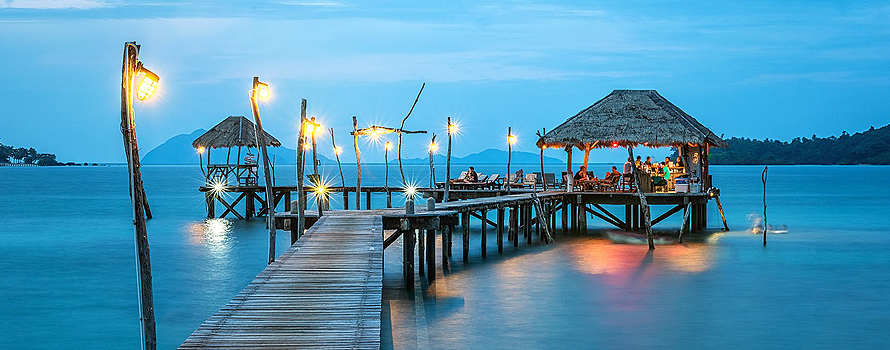
▲ The tourism boom increases electricity consumption in the Caribbean islands, where there are hardly any energy sources of their own.
article / María F. Zambrano
In the Caribbean islands, energy security is at the center of national strategic concern, due to their high dependence on fossil fuels, mostly imported. Energy security is the focus where the geopolitical, diplomatic and economic interests of these small states converge, and not only of them: the great vulnerability due to the lack of their own energy sources was taken into account by Venezuela to promote in 2005 the Petrocaribe cooperation agreement , which gave it great influence in the Antilles; since 2014, the United States has been trying to counteract that program with the Caribbean Energy Security Initiative (CESI), launched by the Obama Administration.
The rivalry between the two energy diplomacy initiatives will not really be settled by a political pulse between Caracas and Washington, but by the real need of the Caribbean islands to diversify their energy sources. This will reduce Venezuela's influence in the region and open the way for the U.S. offer, focused precisely on promoting alternative sources.
The main risk to national security in the Antilles lies in the high costs of Caribbean electricity. On the one hand, the islands have replaced historically agricultural economies with others driven by tourism, which forces them not only to meet the needs of their citizens but also to rely on the fixed cost of an industry with high levels of electricity consumption. On the other hand, production does not have diversified generation Structures . With the exception of Trinidad and Tobago, Suriname and Belize, the islands are supplied by oil as the only installed production capacity; in addition, 87% of primary energy (basically crude oil) is imported. We are facing a problem of high consumption and another of oil dependence.
In view of this status, and given the demands posed by energy security, understood as the physical protection of infrastructure and also the effort to guarantee the continuity of supply, Petrocaribe became a clear option for Antillean interests. Generous financing credits -from 5% to 70% for a 25-year period- contributed to the extension of the program. During the first 10 years of Petrocaribe's existence, from agreement with data of the Latin American and Caribbean Economic System (SELA), Venezuela covered on average 32% of the energy demand of the participating States; the Dominican Republic, Jamaica, Nicaragua and Haiti received 87% of the supplies. The agreement also led to investments in the islands' refineries, which increased their processing capacity to 135,000 barrels of crude oil per day between Cuba's Camilo Cienfuegos refinery (65,000), the refinery near Jamaica's capital (36,000) and the Dominican Petroleum refinery (34,000).
The alliance alleviated for these countries the rise in the price of crude oil, but the region was left in the hands of the volatility of market prices and those of the main supplier. A November 2017 IMFreport estimates that real crude oil price movements affect GDP growth in the Caribbean by 7%, with wide variations from country to country: 15% in Dominica, 9% in Jamaica and less than 1% in Guyana. In turn, the continued drop in Venezuela's production, which began to allocate fewer barrels to Petrocaribe, left the area predisposed to new approaches that would reduce its exhibition to market shocks.
Caribbean Energy Security Initiative
This expectation was addressed in a new energy security framework that sought to increase independence and reduce vulnerability through diversification. Taking advantage of the steep drop in crude oil prices in 2014, which relaxed energy costs for the islands and gave them more room to maneuver, Washington launched the Caribbean Energy Security Initiative (CESI). The program has focused on supporting countries in diversifying electricity generation, addressing their significant renewable energy potential. Thus, through CESI, US$2 million in technical support has been allocated to C-SERMS (Caribbean Sustainable Energy Roadmap and Strategy), a roadmap developed by CARICOM's energy policy division. This roadmap had already harmonized the goals of the 15 member states at subject in terms of energy efficiency and the implementation of renewable energies: two strategies that sought to solve the problems previously mentioned.
The Inter-American Bank of development (IDB) estimated that for the implementation of the C-SERMS roadmap the Caribbean energy sector would require an investment of 7% of the regional GDP between 2018 and 2023. Countries with stronger financial sectors would have the capacity to finance the projects without altering debt sustainability, with these projects being self-financed over a 20-year period.
In the framework of the U.S. initiative, energy efficiency was materialized in the CHEER program (Caribbean Hotel Energy Efficiency and Renewables program) that has provided attendance technical assistance to the hotel industry, the main consumption source . However, in this field, the IMF urges the implementation of broader public policies to further reduce oil imports and increase GDP in the long term deadline.
In the implementation of renewable energy, the U.S. Overseas Private Investment Corporation (OPIC) has promoted infrastructure with public-private financing. Among other projects, it financed the construction of a 36 MW wind power plant and a 20 MW solar power plant, both inaugurated in 2016 in Jamaica. These projects also have macroeconomic influences on reducing dependence on crude oil; in the case of Jamaica, however, dependence has been decreased mainly by the expansion of natural gas receiving capacity, which has allowed that country a reduction from 97% to 80% dependence on imported oil (in fact, it no longer imports Venezuelan crude oil). Since 2016, the business New Fortress Energy has been working on the submission of liquefied natural gas to Jamaica's Bogue plant.
Since its launch, OPIC has financed up to $120 million in energy agreements. Added to that are those promoted by the CEFF-CCA fund, also from the U.S. Government, which provided $20 million non-refundable for projects in initial phases; in 2015 began the project "Clean Energy in the Caribbean", with a duration of five years and with special incidence in Jamaica.
Venezuela... and Trump's clippings
The U.S. initiative for energy diversification in the Caribbean had its response from Venezuela. In 2015, Petrocaribe held a special summit where it quadrupled the ALBA Caribe fund, raising it from $50 million to $200 million, destined to finance mainly social projects, along the lines of what Javier Corrales and Michael Penfold have called "social power diplomacy". However, Venezuela's severe economic crisis and the reduced finances of its national oil company, PDVSA, have forced the government of Nicolás Maduro to cut back on Venezuelan oil diplomacy.
For its part, the arrival of the Trump Administration has led to a significant decrease in the investment earmarked for CESI. In the framework of a generalized cut to financial aid programs abroad, Washington reduced to $4.3 million the amount earmarked for boosting new energy sources in the Caribbean.
The United States, in any case, is not the only one trying to occupy the energy space previously filled by Venezuela. In 2015, the Renewable Energy and Efficient Energy Center was inaugurated in Barbados, promoted by UNID (United Nations Industrial Development Organization) with the support of Austrian and German funds. In addition, last year Russia made fuel shipments to Cuba, replacing supplies that Venezuela had not been able to cover.
The constant expansion of the crop in Mercosur countries has led them to exceed 50% of world production.
Soybean is the agricultural product with the highest commercial growth in the world. The needs of China and India, major consumers of the fruit of this oleaginous plant and its derivatives, make South America a strategic granary. Its profitability has encouraged the extension of the crop, especially in Brazil and Argentina, but also in Paraguay, Bolivia and Uruguay. Its expansion is behind recent deforestation in the Amazon and the Gran Chaco. After hydrocarbons and minerals, soybeans are the other major commodity in South America subject .

article / Daniel Andrés Llonch [English version].
Soybean has been cultivated in Asian civilizations for thousands of years; today its cultivation is also widespread in other parts of the world. It has become the most important oilseed grain for human consumption and animal feed. With great nutritional properties due to its high protein content, soybeans are marketed both in grain and in their oil and meal derivatives.
Of the eleven largest soybean producers, five are in South America: Brazil, Argentina, Paraguay, Bolivia and Uruguay. In 2016, these countries were the origin of 50.6% of world production, whose total reached 334.8 million tons, according to FAO's data . The first producer was the United States (34.9% of world production), followed by Brazil (28.7%) and Argentina (17.5%). India and China follow on the list, although what is significant about the latter country is its large consumption, which in 2016 forced it to import 83.2 million tons. A large part of these import needs are covered from South America. South American production is centered in the Mercosur nations (in addition to Brazil and Argentina, also Paraguay and Uruguay) and Bolivia.
Strong international demand and the high relative profitability of soybeans in recent years have fueled the expansion of soybean cultivation in the Mercosur region. The commodity price boom, in which soybeans also participated, led to profits that were directed to the acquisition of new land and equipment, allowing producers to increase their scale and efficiency.
In Argentina, Bolivia, Brazil and Paraguay, the area planted with soybean is the majority (it constitutes more than 50% of the total area planted with the five most important crops in each country). If to group we add Uruguay, where soybean has enjoyed a later expansion, we have that the production of these five South American countries has gone from 99 million tons in 2006 to 169.7 million in 2016, which is an increase of 71.2% (Brazil and Bolivia have almost doubled their production, somewhat surpassed by Paraguay and Uruguay, a country where it has tripled). In the decade, this South American area has gone from contributing 44.7% of world production to total 50.6%. In that time, the cultivated area increased from 40.6 million hectares to 58.4 million hectares.
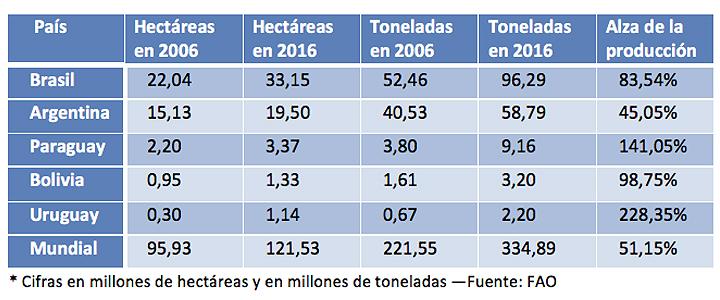 |
Countries
As the second largest soybean producer in the world, Brazil reached in 2016 a production of 96.2 million tons (28.7% of the world total), with a crop area of 33.1 million hectares. Its production has known a constant increase, so that in the last decade the volume of the crop has increased by 83.5%. The jump has been especially B in the last four years, in which Brazil and Argentina have experienced the highest rate of increase of the crop, with an annual average of 936,000 and 878,000 hectares, respectively, from agreement with the United States Department of Agriculture (USDA) department .
Argentina is the second largest producer in Mercosur, with 58.7 million tons (17.5% of world production) and a cultivated area of 19.5 million hectares. Soybean began to be planted in Argentina in the mid 1970s, and in less than 40 years it has made unprecedented progress. This crop occupies 63% of the country's areas planted with the five most important crops, compared to 28% of the area occupied by corn and wheat.
Paraguay, meanwhile, had a 2016 harvest of 9.1 million tons of soybeans (2.7% of world production). In recent seasons, soybean production has increased as more land is allocated for its cultivation. From agreement with the USDA, over the last two decades, land devoted to soybean cultivation has steadily increased by 6% annually. There are currently 3.3 million hectares of land in Paraguay dedicated to this activity, which constitutes 66% of the land used for the main crops.
In Bolivia, soybeans are grown mainly in the Santa Cruz region. According to the USDA, it accounts for 3% of the country's Gross Domestic Product, and employs 45,000 workers directly. In 2016, the country harvested 3.2 million tons (0.9% of world production), on an area of 1.3 million hectares.
Soybean plantations occupy more than 60 percent of the arable land in Uruguay, where soybean production has been increasing in recent years. In fact, it is the country where production has grown the most in relative terms in the last decade (67.7%), reaching 2.2 million tons in 2016 and a cultivated extension of 1.1 million hectares.
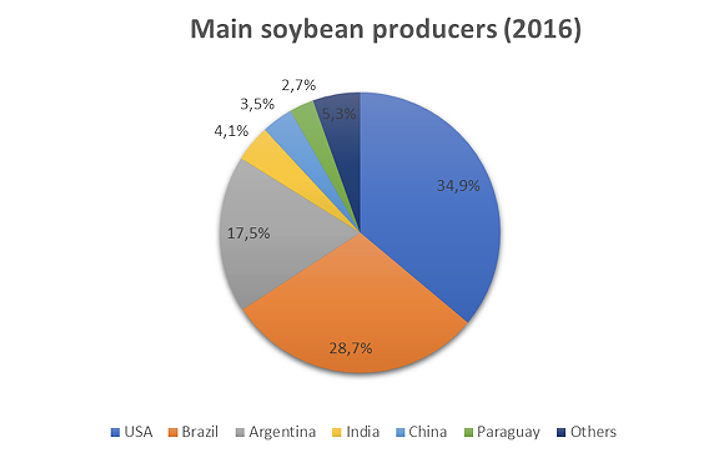 |
Increased demand
Soybean production represents a very important fraction of the agricultural GDP of South American nations. The five countries mentioned above, together with the United States, account for 85.6% of global production, making them the main suppliers of the growing world demand.
This production has experienced a progressive increase since its insertion in the market, with the exception of Uruguay, whose expansion of the product has been more recent. In the period between 1980 and 2005, for example, total world soybean demand expanded by 174.3 million tons, or 2.8 times. During this period, the growth rate of global demand accelerated from 3% per year in the 1980s to 5.6% per year in the last decade.
In all the South American countries mentioned above, soybean cultivation has been especially encouraged, due to the benefits it brings. Thus, in Brazil, the largest regional producer of the oleaginous grain, soybeans contribute revenues estimated at 10 billion dollars in exports, representing 14% of the total products marketed by the country. In Argentina, soybean cultivation went from representing 10.6% of agricultural production in 1980/81 to more than 50% in 2012/2013, generating significant economic benefits.
The outlook for growth in demand suggests that production will continue to rise. The Food and Agriculture Organization of the United Nations estimates that global production will exceed 500 million tons in 2050, double the volume harvested in 2010. Much of this demand will have to be met from South America.


![The main Russian gas pipelines to Eastern and Central Europe [Samuel Bailey/CC]. The main Russian gas pipelines to Eastern and Central Europe [Samuel Bailey/CC].](/documents/10174/16849987/nordstream-blog-2.png)
